Abstract
Pain has been a major concern of humankind since the ancient times, and it remains one of the most important subjects of all health care professionals. Despite the obvious overwhelming clinical importance, the major advances in its diagnosis and therapy have been made only recently. "How do the sensory apparatus of the body and system of signal transmission relate to pain of peripheral origin?" is the topic of discussion. To do this, it is important to understand what constitutes the total pain experience. It consists of: 1) signal transduction at the peripheral receptor site, 2) signal conduction along the peripheral nerve, 3) pain modulation at the level of the spinal cord, 4) pain perception at the supraspinal site, and 5) the associated sensations, emotional reactions, and effective state. The signal transmission related to pain may be modified by various analgesic agents. Specific analgesic agent has a specific site of action which may be at peripheral receptors, at peripheral nerves, at the level of the spinal cord, at supraspinal levels by activating descending inhibitory systems, or at more cephalad levels by reducing the affective component of pain.
Full text
PDF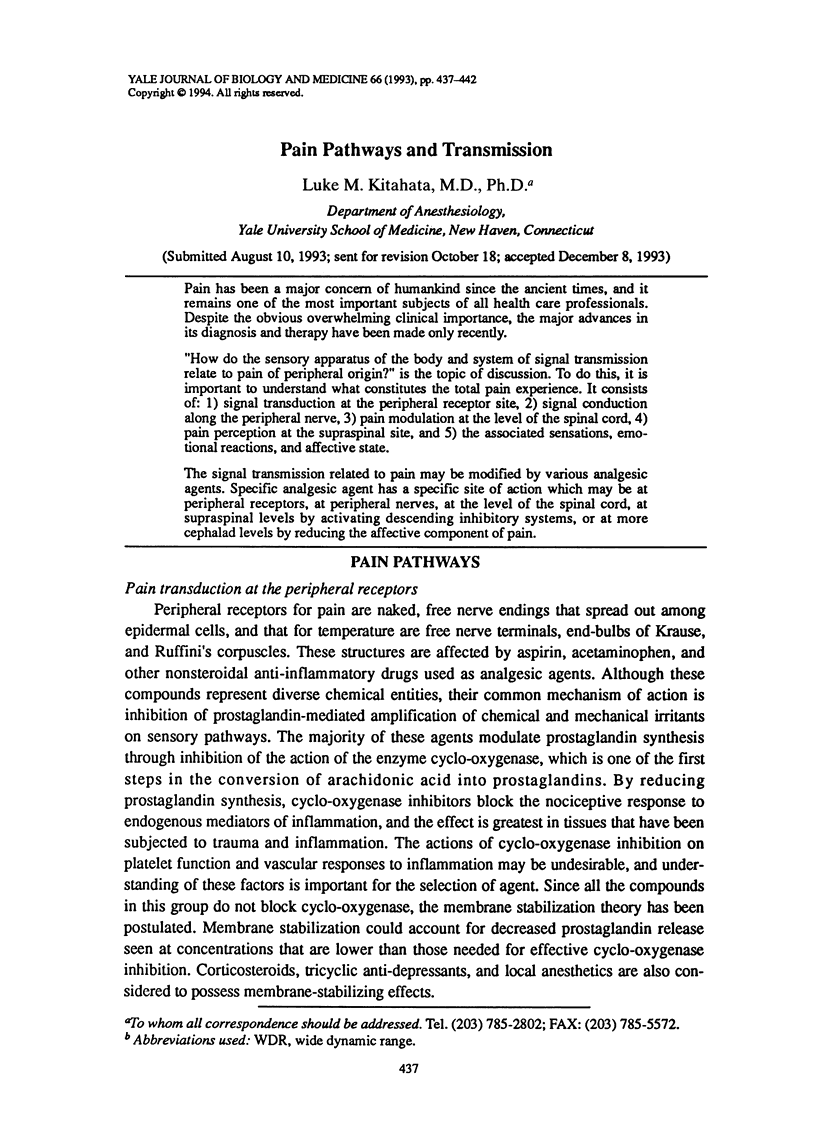
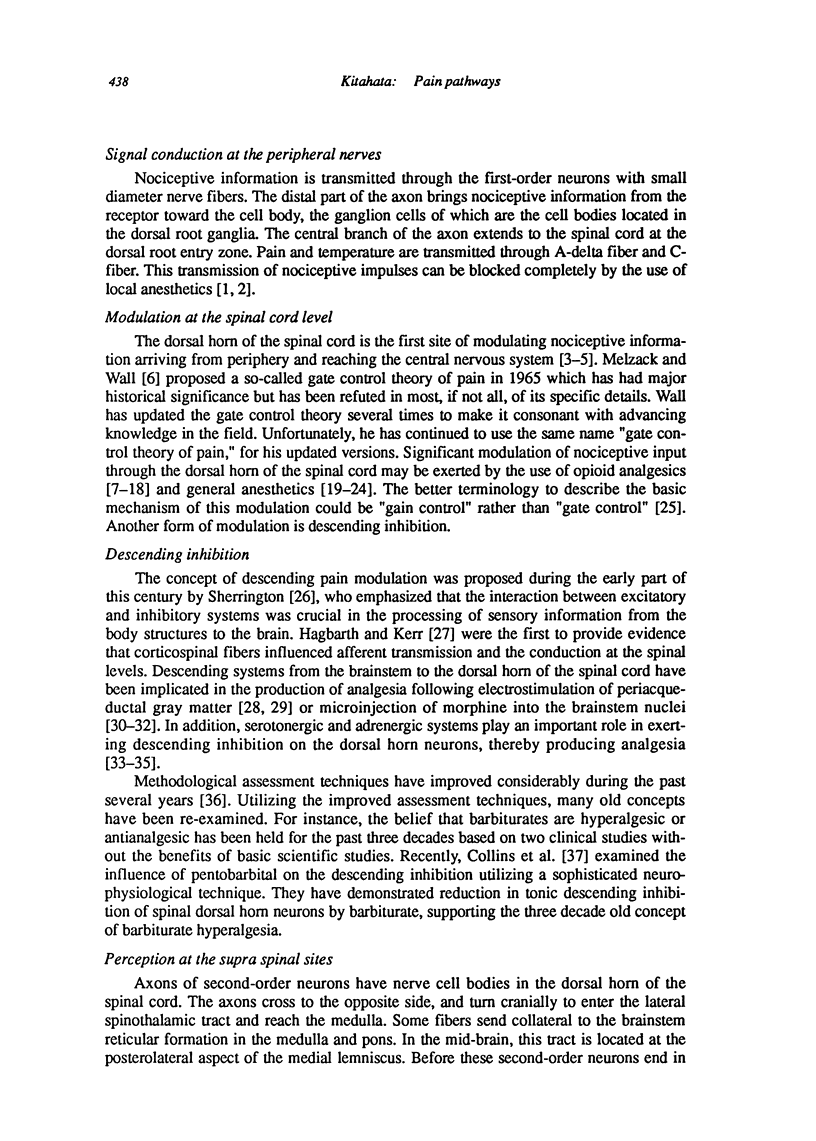
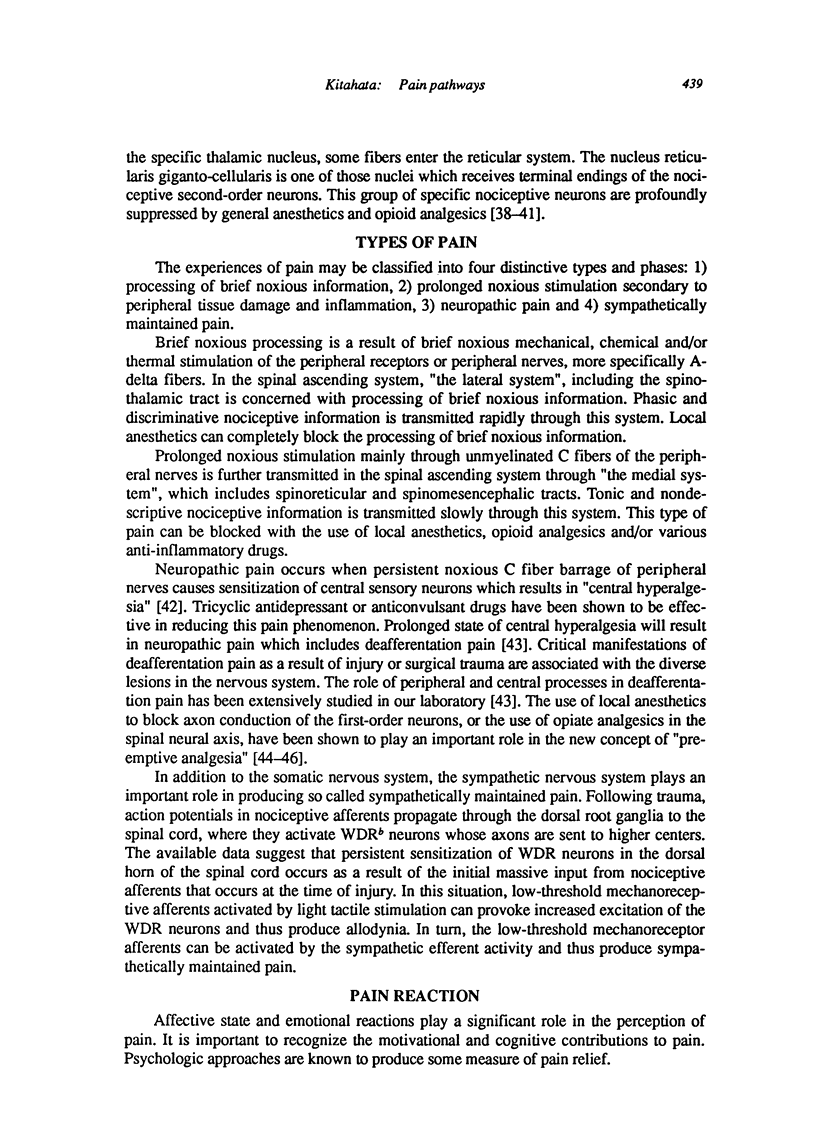
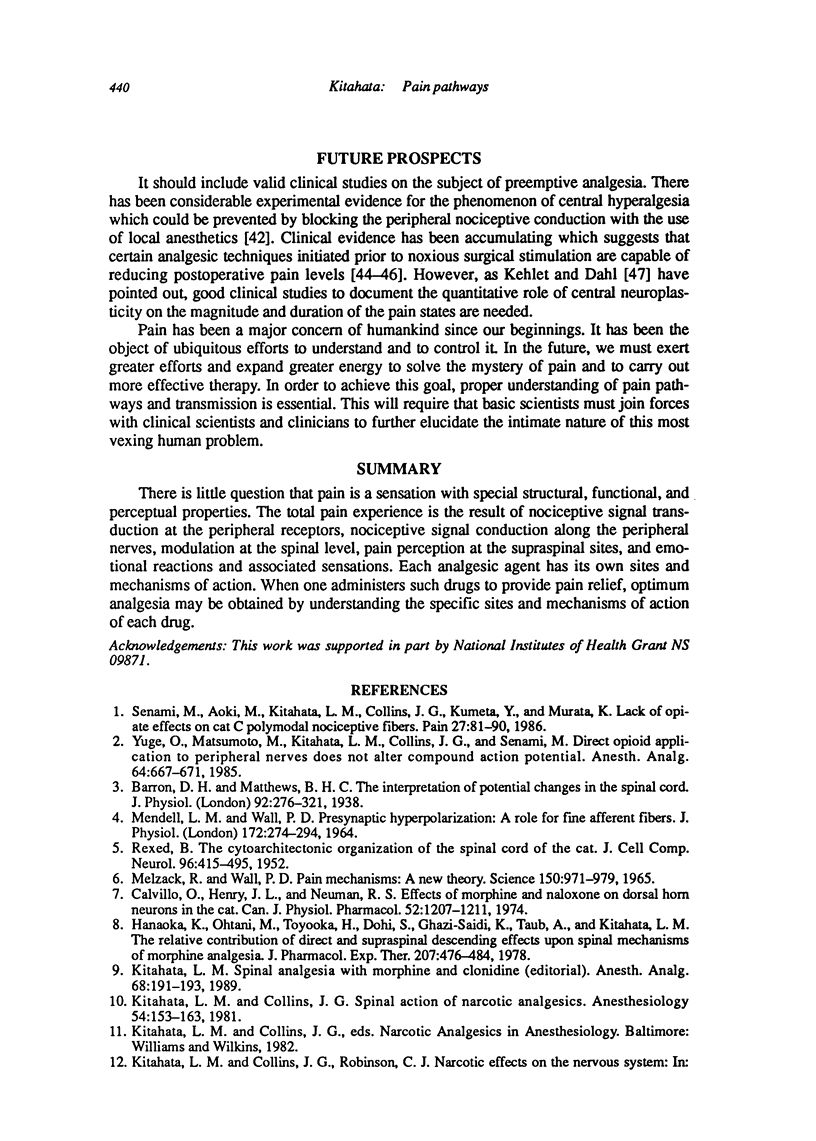
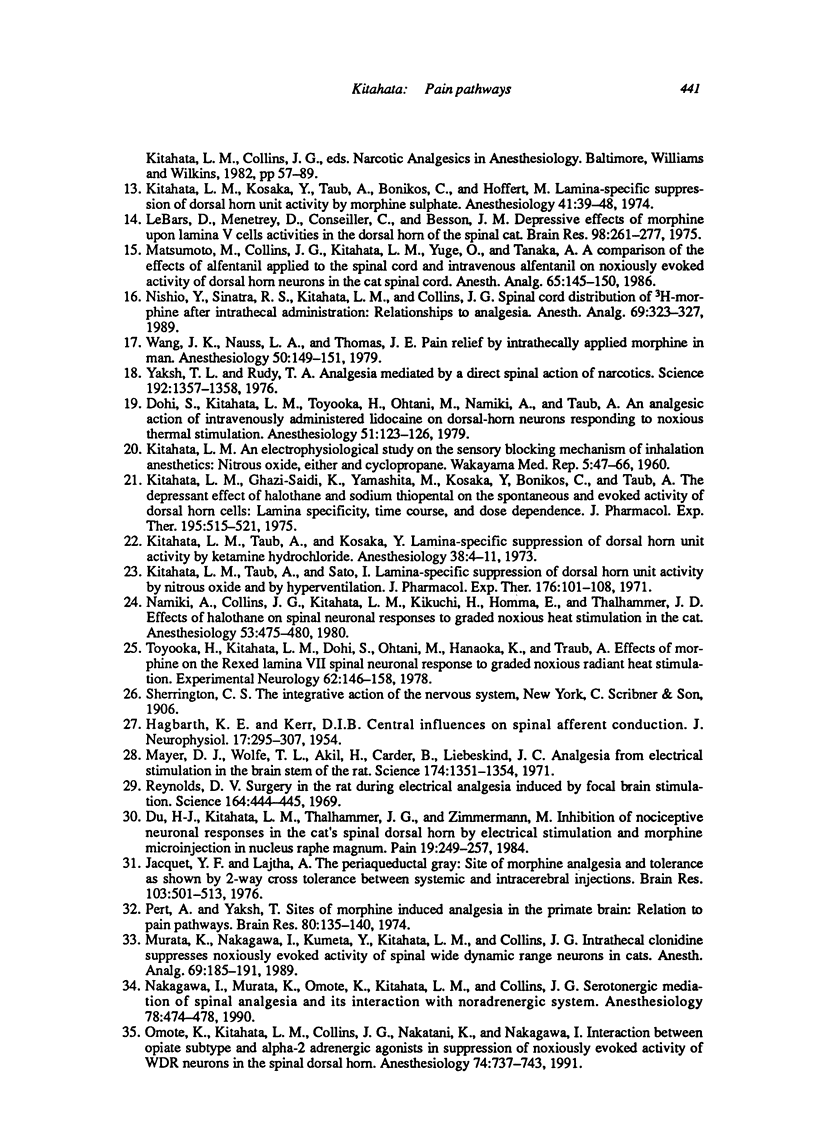

Selected References
These references are in PubMed. This may not be the complete list of references from this article.
- Bach S., Noreng M. F., Tjéllden N. U. Phantom limb pain in amputees during the first 12 months following limb amputation, after preoperative lumbar epidural blockade. Pain. 1988 Jun;33(3):297–301. doi: 10.1016/0304-3959(88)90288-6. [DOI] [PubMed] [Google Scholar]
- Barron D. H., Matthews B. H. The interpretation of potential changes in the spinal cord. J Physiol. 1938 Apr 14;92(3):276–321. doi: 10.1113/jphysiol.1938.sp003603. [DOI] [PMC free article] [PubMed] [Google Scholar]
- Calvillo O., Henry J. L., Neuman R. S. Effects of morphine and naloxone on dorsal horn neurones in the cat. Can J Physiol Pharmacol. 1974 Dec;52(6):1207–1211. doi: 10.1139/y74-158. [DOI] [PubMed] [Google Scholar]
- Collins J. G., Ren K., Saito Y., Iwasaki H., Tang J. Plasticity of some spinal dorsal horn neurons as revealed by pentobarbital-induced disinhibition. Brain Res. 1990 Aug 20;525(2):189–197. doi: 10.1016/0006-8993(90)90863-7. [DOI] [PubMed] [Google Scholar]
- Dohi S., Kitahata L. M., Toyooka H., Ohtani M., Namiki A., Taub A. An analgesic action of intranvenously administered lidocaine on dorsal-horn neurons responding to noxious thermal stimulation. Anesthesiology. 1979 Aug;51(2):123–126. doi: 10.1097/00000542-197908000-00006. [DOI] [PubMed] [Google Scholar]
- Du H. J., Kitahata L. M., Thalhammer J. G., Zimmermann M. Inhibition of nociceptive neuronal responses in the cat's spinal dorsal horn by electrical stimulation and morphine microinjection in nucleus raphe magnus. Pain. 1984 Jul;19(3):249–257. doi: 10.1016/0304-3959(84)90003-4. [DOI] [PubMed] [Google Scholar]
- HAGBARTH K. E., KERR D. I. Central influences on spinal afferent conduction. J Neurophysiol. 1954 May;17(3):295–307. doi: 10.1152/jn.1954.17.3.295. [DOI] [PubMed] [Google Scholar]
- Hanaoka K., Ohtani M., Toyooka H., Dohi S., Ghazisaidi K., Taub A., Kitahata L. M. The relative contribution of direct and supraspinal descending effects upon spinal mechanisms of morphine analgesia. J Pharmacol Exp Ther. 1978 Nov;207(2):476–484. [PubMed] [Google Scholar]
- Jacquet Y. F., Lajtha A. The periaqueductal gray: site of morphine analgesia and tolerance as shown by 2-way cross tolerance between systemic and intracerebral injections. Brain Res. 1976 Feb 27;103(3):501–513. doi: 10.1016/0006-8993(76)90448-0. [DOI] [PubMed] [Google Scholar]
- Kikuchi H., Kitahata L. M., Collins J. G., Kawahara M., Nio K. Halothane-induced changes in neuronal activity of cells of the nucleus reticularis gigantocellularis of the cat. Anesth Analg. 1980 Dec;59(12):897–901. [PubMed] [Google Scholar]
- Kitahata L. M., Collins J. G. Spinal action of narcotic analgesics. Anesthesiology. 1981 Feb;54(2):153–163. doi: 10.1097/00000542-198102000-00010. [DOI] [PubMed] [Google Scholar]
- Kitahata L. M., Ghazi-Saidi K., Yamashita M., Kosaka Y., Bonikos C., Taub A. The depressant effect of halothane and sodium thiopental on the spontaneous and evoked activity of dorsal horn cells: lamina specificity, time course and dose dependence. J Pharmacol Exp Ther. 1975 Dec;195(3):515–521. [PubMed] [Google Scholar]
- Kitahata L. M., Kosaka Y., Taub A., Bonikos K., Hoffert M. Lamina-specific suppression of dorsal-horn unit activity by morphine sulfate. Anesthesiology. 1974 Jul;41(1):39–48. doi: 10.1097/00000542-197407000-00008. [DOI] [PubMed] [Google Scholar]
- Kitahata L. M., Saberski L. Are barbiturates hyperalgesic? Anesthesiology. 1992 Dec;77(6):1059–1061. doi: 10.1097/00000542-199212000-00001. [DOI] [PubMed] [Google Scholar]
- Kitahata L. M. Spinal analgesia with morphine and clonidine. Anesth Analg. 1989 Mar;68(3):191–193. [PubMed] [Google Scholar]
- Kitahata L. M., Taub A., Kosada Y. Lamina-specific suppression of dorsal-horn unit activity by detamine hydrochloride. Anesthesiology. 1973 Jan;38(1):4–11. doi: 10.1097/00000542-197301000-00003. [DOI] [PubMed] [Google Scholar]
- Kitahata L. M., Taub A., Sato I. Lamina-specific suppression of dorsal horn unit activity by nitrous oxide and by hyperventilation. J Pharmacol Exp Ther. 1971 Jan;176(1):101–108. [PubMed] [Google Scholar]
- LaMotte R. H., Shain C. N., Simone D. A., Tsai E. F. Neurogenic hyperalgesia: psychophysical studies of underlying mechanisms. J Neurophysiol. 1991 Jul;66(1):190–211. doi: 10.1152/jn.1991.66.1.190. [DOI] [PubMed] [Google Scholar]
- Le Bars D., Menétrey D., Conseiller C., Besson J. M. Depressive effects of morphine upon lamina V cells activities in the dorsal horn of the spinal cat. Brain Res. 1975 Nov 14;98(2):261–277. doi: 10.1016/0006-8993(75)90005-0. [DOI] [PubMed] [Google Scholar]
- MENDELL L. M., WALL P. D. PRESYNAPTIC HYPERPOLARIZATION: A ROLE FOR FINE AFFERENT FIBRES. J Physiol. 1964 Aug;172:274–294. doi: 10.1113/jphysiol.1964.sp007417. [DOI] [PMC free article] [PubMed] [Google Scholar]
- Matsumoto M., Collins J. G., Kitahata L. M., Yuge O., Tanaka A. A comparison of the effects of alfentanil applied to the spinal cord and intravenous alfentanil on noxiously evoked activity of dorsal horn neurons in the cat spinal cord. Anesth Analg. 1986 Feb;65(2):145–150. [PubMed] [Google Scholar]
- Mayer D. J., Wolfle T. L., Akil H., Carder B., Liebeskind J. C. Analgesia from electrical stimulation in the brainstem of the rat. Science. 1971 Dec 24;174(4016):1351–1354. doi: 10.1126/science.174.4016.1351. [DOI] [PubMed] [Google Scholar]
- McQuay H. J., Carroll D., Moore R. A. Postoperative orthopaedic pain--the effect of opiate premedication and local anaesthetic blocks. Pain. 1988 Jun;33(3):291–295. doi: 10.1016/0304-3959(88)90287-4. [DOI] [PubMed] [Google Scholar]
- Melzack R., Wall P. D. Pain mechanisms: a new theory. Science. 1965 Nov 19;150(3699):971–979. doi: 10.1126/science.150.3699.971. [DOI] [PubMed] [Google Scholar]
- Mosso J. A., Kruger L. Spinal trigeminal neurons excited by noxious and thermal stimuli. Brain Res. 1972 Mar 10;38(1):206–210. doi: 10.1016/0006-8993(72)90605-1. [DOI] [PubMed] [Google Scholar]
- Murata K., Nakagawa I., Kumeta Y., Kitahata L. M., Collins J. G. Intrathecal clonidine suppresses noxiously evoked activity of spinal wide dynamic range neurons in cats. Anesth Analg. 1989 Aug;69(2):185–191. [PubMed] [Google Scholar]
- Nakagawa I., Omote K., Kitahata L. M., Collins J. G., Murata K. Serotonergic mediation of spinal analgesia and its interaction with noradrenergic systems. Anesthesiology. 1990 Sep;73(3):474–478. doi: 10.1097/00000542-199009000-00017. [DOI] [PubMed] [Google Scholar]
- Namiki A., Collins J. G., Kitahata L. M., Kikuchi H., Homma E., Thalhammer J. G. Effects of halothane on spinal neuronal responses to graded noxious heat stimulation in the cat. Anesthesiology. 1980 Dec;53(6):475–480. doi: 10.1097/00000542-198012000-00007. [DOI] [PubMed] [Google Scholar]
- Nishio Y., Sinatra R. S., Kitahata L. M., Collins J. G. Spinal cord distribution of 3H-morphine after intrathecal administration: relationship to analgesia. Anesth Analg. 1989 Sep;69(3):323–327. [PubMed] [Google Scholar]
- Ohtani M., Kikuchi H., Kitahata L. M., Taub A., Toyooka H., Hanaoka K., Dohi S. Effects of ketamine on nociceptive cells in the medial medullary reticular formation of the cat. Anesthesiology. 1979 Nov;51(5):414–417. doi: 10.1097/00000542-197911000-00009. [DOI] [PubMed] [Google Scholar]
- Omote K., Kitahata L. M., Collins J. G., Nakatani K., Nakagawa I. Interaction between opiate subtype and alpha-2 adrenergic agonists in suppression of noxiously evoked activity of WDR neurons in the spinal dorsal horn. Anesthesiology. 1991 Apr;74(4):737–743. doi: 10.1097/00000542-199104000-00018. [DOI] [PubMed] [Google Scholar]
- Pert A., Yaksh T. Sites of morphine induced analgesia in the primate brain: relation to pain pathways. Brain Res. 1974 Nov 8;80(1):135–140. doi: 10.1016/0006-8993(74)90731-8. [DOI] [PubMed] [Google Scholar]
- REXED B. The cytoarchitectonic organization of the spinal cord in the cat. J Comp Neurol. 1952 Jun;96(3):414–495. doi: 10.1002/cne.900960303. [DOI] [PubMed] [Google Scholar]
- Reynolds D. V. Surgery in the rat during electrical analgesia induced by focal brain stimulation. Science. 1969 Apr 25;164(3878):444–445. doi: 10.1126/science.164.3878.444. [DOI] [PubMed] [Google Scholar]
- Senami M., Aoki M., Kitahata L. M., Collins J. G., Kumeta Y., Murata K. Lack of opiate effects on cat C polymodal nociceptive fibers. Pain. 1986 Oct;27(1):81–90. doi: 10.1016/0304-3959(86)90225-3. [DOI] [PubMed] [Google Scholar]
- Toyooka H., Kitahata L. M., Dohi S., Ohtani M., Hanaoka K., Taub A. Effects of morphine on the rexed lamina VII spinal neuronal response to graded noxious radiant heat stimulation. Exp Neurol. 1978 Oct;62(1):146–158. doi: 10.1016/0014-4886(78)90047-x. [DOI] [PubMed] [Google Scholar]
- Tverskoy M., Cozacov C., Ayache M., Bradley E. L., Jr, Kissin I. Postoperative pain after inguinal herniorrhaphy with different types of anesthesia. Anesth Analg. 1990 Jan;70(1):29–35. doi: 10.1213/00000539-199001000-00006. [DOI] [PubMed] [Google Scholar]
- Wang J. K., Nauss L. A., Thomas J. E. Pain relief by intrathecally applied morphine in man. Anesthesiology. 1979 Feb;50(2):149–151. doi: 10.1097/00000542-197902000-00013. [DOI] [PubMed] [Google Scholar]
- Yaksh T. L., Rudy T. A. Analgesia mediated by a direct spinal action of narcotics. Science. 1976 Jun 25;192(4246):1357–1358. doi: 10.1126/science.1273597. [DOI] [PubMed] [Google Scholar]
- Yuge O., Kitahata L. M., Collins J. G., Matsumoto M., Tabatabai M., Suzukawa M., Tanaka A. Fentanyl and alfentanil suppress brainstem pain transmission. Anesth Analg. 1985 Jun;64(6):597–600. [PubMed] [Google Scholar]
- Yuge O., Matsumoto M., Kitahata L. M., Collins J. G., Senami M. Direct opioid application to peripheral nerves does not alter compound action potentials. Anesth Analg. 1985 Jul;64(7):667–671. [PubMed] [Google Scholar]


